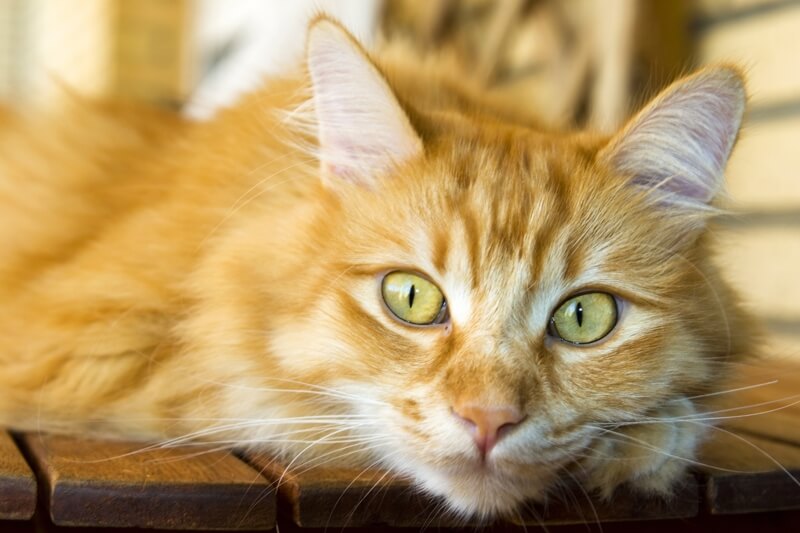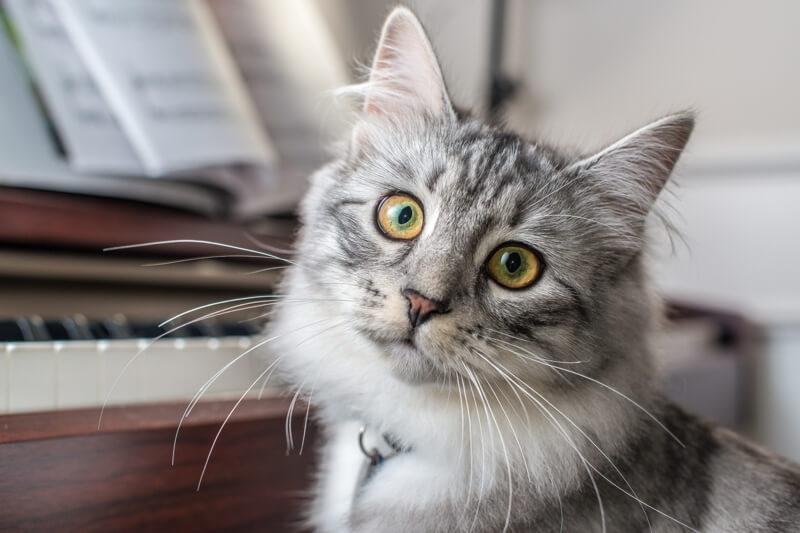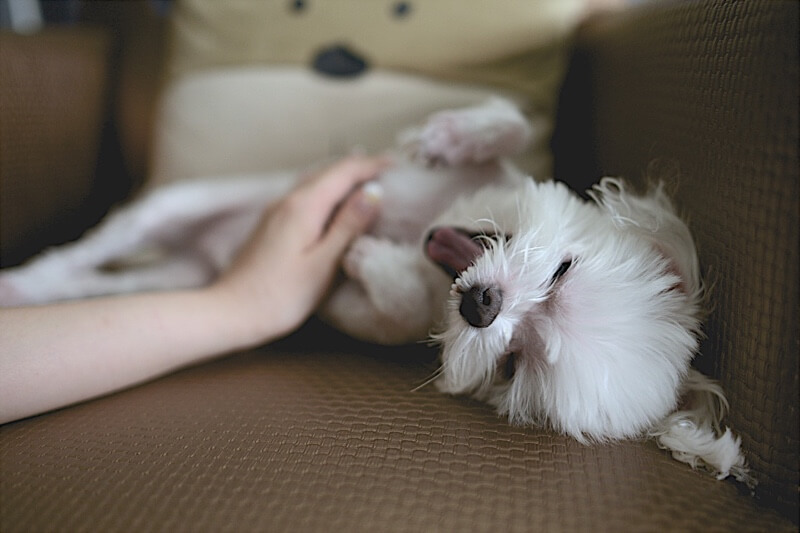Ya tebya lyublyu! That means, “I love you,” in Russian. If you’ve never met a Siberian cat before, you’re going to want to learn that phrase now so you can tell the first one you come across just how incredible they are. Powerful and highly intelligent, these gentle giants are soft at heart and get along with just about everyone – even dogs.
Siberian Cat Basics
Siberian cats, also called Siberian Forest cats or Moscow Longhairs, are a medium to large semi-longhair breed with males ranging from 15 to 20 pounds and females only slightly smaller.
They are strong, alert, and adventurous with lustrous coats and round, curious eyes. Siberians are a landrace breed, meaning they developed over time by adapting to their surroundings – which explains the thick coats needed to face those harsh Russian winters!
Because of their easygoing personalities and relatively low maintenance, they make great additions to active households full of kids and other furry family members.

Origin & History
Siberian cats are believed to have originated in the dense forests of Siberia at least 1,000 years ago. Some people even think these silky beauties are the ancestors to all modern longhair cats. Little is known of their early stages, but these kitties most likely became domesticated when they sought out farms, shops, and monasteries as an escape from the brutal Siberian temperatures. Their first pet parents would have welcomed them for their sharp hunting skills, which meant fewer rodents indoors.
Siberian cats probably traveled to the U.K. with Russian immigrants, though we can’t be sure of when exactly. Their first mention in Jolly Old England was in Harrison Weir's late 19th-century book Our Cats and All About Them where he mentioned them as participants in early cat shows. Believe it or not, Siberian cats didn’t make it to the U.S. until 1990. They were incredibly expensive to import, but an enthusiast from Baton Rouge, La., named Elizabeth Terrell finally negotiated terms to bring a few over by exchanging four of her Himalayans. She welcomed one male, Kaliostro Vasenjkovich, and two females, Ofelia Romanova and Naina Romanova. Siberian cats are still fairly rare in the U.S.

Attributes
Stocky yet agile, Siberian cats are powerfully built with strong hind legs that are slightly longer than their front legs, creating an arch. This makes them skilled jumpers and incredible athletes. They resemble Maine Coons and Norwegian Forest cats but with rounder heads and larger paws. They also have distinct round eyes, typically green or gold, that give them a friendly expression.
From tufted ears to exquisite neck ruff to their big, bushy tail, the most remarkable attribute of a Siberian is their thick, three-layered coat. It consists of coarse and straight guard hairs, thin and wavy awn hairs, and a wooly down undercoat. Tabbies are common, but Siberians come in a variety of colors and patterns, including solid, tortoiseshell, and color point.
With their athletic ability and high intelligence level, it’s no surprise that Siberian cats are energetic and adventurous problem solvers. They love climbing and leaping. If you are a pet parent to a Siberian, expect to find them in the strangest places – like on top of your refrigerator, hanging over a door, or even swinging from your chandelier! Siberians also enjoy playing with puzzle toys and learning tricks.
Affection-wise, they are devoted but not clingy. Siberians will follow you from room to room but patiently wait until you have time for cuddles. They don’t mind noises or strangers as much as most cats, and if introduced properly, they are happy to cohabitate with kids, dogs, and whoever else may live in your home.

Grooming & Care
Siberians are all kinds of fluffy, so you may worry that these kitties need a lot of grooming. Not so! Although they have a three-layered coat, Siberians have glossy fur that you only need to brush once or twice a week to avoid tangles and matting. They molt heavily at the end of winter and then have a lighter molting in the summer, so it’s a good idea to brush your pal daily during these times.
Trim your kitty’s nails weekly, and check their ears for redness or unpleasant odors. If you notice any buildup, clean gently with a damp cotton ball and contact your veterinarian in case it’s a sign of an ear infection. You should also brush your feline friend’s teeth a few times a week.
Are Siberian Cats Hypoallergenic?
Some folks claim that Siberian cats are hypoallergenic, meaning you won’t get an allergic reaction from enjoying cat cuddles. It’s true that Siberian cats do produce less Fel d1, the protein found on skin and in saliva that causes those itchy, sneezy reactions, but unfortunately, even small amounts of Fel d1 can make your eyes water. Siberians also produce dander, which can definitely irritate allergies.
Special Siberian Care Tips
While it’s true that Siberians aren’t clingy, they are communal by nature. If you’re thinking of adopting one, you should consider adopting two. They tend to thrive when they have a kitty comrade by their side.
Your Siberian’s daredevil antics can be entertaining – a cat swinging from a chandelier, come on! – but don’t forget to protect your kitty from any potential dangers. Avoid displaying glass ornaments or other breakable objects on high shelves, and consider buying a ceiling-height cat tree to keep your li’l buddy entertained.

Common Health Issues
As a natural breed, Siberian cats are hearty and healthy. The only congenital disease to be on the lookout for with these furry sweethearts is hypertrophic cardiomyopathy (HCM). The most common of all heart diseases in cats, HCM is a thickening of the heart muscle that could lead to heart failure. If you have a Siberian kitty, it’s a good idea to ask your veterinarian to perform a screening.
Siberian cats reach reproductive maturity earlier than most breeds – some as young as five months – and produce larger litters. Of course, our strategic partner the American Society for the Prevention of Cruelty to Animals® (ASPCA®) advises to keep all cats indoors, so unless you have other feline family members, you probably aren’t planning on your kitty having contact with other cats. But, it never hurts to play it safe and have their spay or neuter procedure done right away.
Top 5 Siberian Cat Fun Facts
With such lovable, adventurous personalities, Siberian cats have no shortage of fun facts. Here are a few of our favorites:
- The Siberian cat is the national cat of Russia.
- Unlike many of our furry friends, a Siberian cat’s molting is not triggered by a change in temperature but rather by the change in daylight hours.
- The 2016 movie Nine Lives stars Kevin Spacey, who plays a workaholic father whose mind gets stuck inside of his daughter’s Siberian cat.
- Siberians take parenting very seriously. Mama cats often only mate with one male, and these nurturing cat dads play a big part in caring for their kittens.
- Siberian cats have water-repellant coats and actually enjoy water. Don’t be surprised if your Siberian pal tries to join you in the shower!

Naming Your Siberian Cat
Naming a furry family member is a big job – especially with Siberians who are known for having big personalities. You could name yours after the rivers and lakes in Siberia:
- Lena
- Amur
- Obie (after the River Ob)
- Yenisei
- Baikal
What about Lizzie after Elizabeth Terrel who brought Siberian cats to the U.S.? Or Naina after one of her first Siberian cats? Here are a few other suggestions based on famous explorers who share the Siberian’s adventuresome spirit:
- Magellan
- Lewis
- Boone
- Leif
- Yuri
No matter what name you settle on, you’ll want to make sure your Siberian is covered – from sweet purrs to tufted paws. Get an ASPCA Pet Health Insurance quote today!







